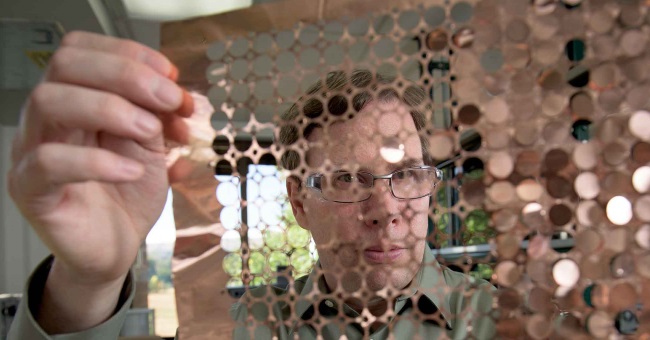The Energy Department's National Renewable Energy Laboratory (NREL) recently patented the Internal Short Circuit (ISC) device to enhance battery designs by testing the effects of a latent internal short circuit and related escalating temperatures. These shorts can lead to thermal runaway and hazards for drivers, air passengers—and even astronauts. Using the tiny, easy-to-implant ISC device for diagnostics and licensing it to industry is an important step in removing those obstacles and making batteries used in EDVs as safe as possible. While naturally occurring internal short circuits are caused by a multitude of factors, these events are usually triggered by a minor internal flaw, such as a small foreign particle that was introduced to the battery cell during the manufacturing process.

NREL Senior Engineer Mathew Keyser holds a sheet of copper discs, one of the metal components that comprise the NREL Internal Short Circuit (ISC) device, capable of emulating latent defects that can cause escalating temperatures in lithium ion batteries and lead to thermal runaway. Industry can use the NREL ISC device to evaluate solutions intended to address this issue. ( Photo by Ellen Jaskol, NREL)
Knowing how to predict the behavior of a battery cell through the use of NREL's ISC device may also prevent circumstances that lead to thermal runaway. If an internal short does occur, containing thermal runaway to a single cell can limit the damage. The device can help battery manufacturers determine how to best minimize the spread of thermal runaway through design measures, such as placing barriers between cells, ensuring that vents are directed away from other cells, and taking special precautions with electrical connections between cells. Built into the battery being tested, the new NREL tool is the first capable of replicating a naturally occurring internal short without tampering with the cell exterior. The NREL device acts as a thermal switch contained completely within the cell, delivering consistent and controllable reactions. The ISC device can be placed in any location within a cell and produce all four types of shorts—electrode to electrode, electrode to cathode, electrode to anode, and cathode to anode—each of which illicit different responses, from benign to severe.
The genius of the ISC device can be attributed in part to its simplicity. It is comprised of a small copper and aluminum disc, a copper puck, polyethylene or polypropylene separator, and thin layer of wax (as thin as the diameter of one strand of hair). After implantation of the device in a cell, an internal short circuit is induced by exposing the cell to higher temperatures and melting the thin layer of wax, which is then wicked away by the separator, cathode, and anode, leaving the remaining metal components come into contact and induce an internal short. Sensors record the cell's reactions. However, in-depth research was required to identify the best but sometimes unconventional components for the device, such as the right wax. The melting point of wax has a melting point ranging from 30° to 150°C, but researchers discovered that paraffin wax used in candles was too brittle and would crack when wound into the jelly roll of a battery cell. They finally settled on microcrystalline wax, which is much more pliant and is used in a wide range of non-technical applications, including cosmetics and hairspray. A mixture of microcrystalline with paraffin wax created the perfect level of tackiness, malleability, and firmness to produce a consistent internal short circuit when it melted.
After testing Li-ion batteries at different cycle stages for the past five years, NREL is now entering into conversations with battery manufacturers about producing the device on a larger scale. The lab continues to work with NASA on further improving spacesuit battery safety with modeling, and more automotive battery manufacturers are embracing the benefits delivered by the ISC device. In addition to the ISC device, NREL researchers are evaluating battery safety issues at multiple scales using a variety of models and simulation tools. At the particle scale, investigations of surface modifications help prevent electrolyte decomposition and subsequent gas generation. Pack-level modeling explores the propagation of stress build-up during abuse scenarios.
As more and more manufacturing companies gain access to the ISC device, NREL expects to see a significant industry-wide shift in Li-ion battery design and material selection, by helping to choose the right configurations and components that make batteries safer. Learn more about NREL's energy storage and battery safety research.
Advertisement





